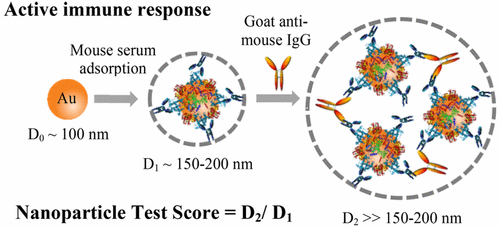当前位置:
X-MOL 学术
›
ACS Infect. Dis.
›
论文详情
Our official English website, www.x-mol.net, welcomes your
feedback! (Note: you will need to create a separate account there.)
A Rapid Blood Test To Determine the Active Status and Duration of Acute Viral Infection
ACS Infectious Diseases ( IF 4.0 ) Pub Date : 2017-09-20 00:00:00 , DOI: 10.1021/acsinfecdis.7b00137 Tianyu Zheng 1 , Caroline Finn 2 , Christopher J. Parrett 2 , Kunal Dhume 2 , Ji Hae Hwang 2 , David Sidhom 2 , Tara M. Strutt 2 , Yuen Yee Li Sip 2 , Karl K. McKinstry 2 , Qun Huo 1
ACS Infectious Diseases ( IF 4.0 ) Pub Date : 2017-09-20 00:00:00 , DOI: 10.1021/acsinfecdis.7b00137 Tianyu Zheng 1 , Caroline Finn 2 , Christopher J. Parrett 2 , Kunal Dhume 2 , Ji Hae Hwang 2 , David Sidhom 2 , Tara M. Strutt 2 , Yuen Yee Li Sip 2 , Karl K. McKinstry 2 , Qun Huo 1
Affiliation

|
The ability to rapidly detect and diagnose acute viral infections is crucial for infectious disease control and management. Serology testing for the presence of virus-elicited antibodies in blood is one of the methods used commonly for clinical diagnosis of viral infections. However, standard serology-based tests have a significant limitation: they cannot easily distinguish active from past, historical infections. As a result, it is difficult to determine whether a patient is currently infected with a virus or not, and on an optimal course of action, based off of positive serology testing responses. Here, we report a nanoparticle-enabled blood test that can help overcome this major challenge. The new test is based on the analysis of virus-elicited immunoglobulin G (IgG) antibody present in the protein corona of a gold nanoparticle surface upon mixing the gold nanoparticles with blood sera. Studies conducted on mouse models of influenza A virus infection show that the test gives positive responses only in the presence of a recent acute viral infection, approximately between day 14 and day 21 following the infection, and becomes negative thereafter. When used together with the traditional serology testing, the nanoparticle test can determine clearly whether a positive serology response is due to a recent or historical viral infection. This new blood test can provide critical clinical information needed to optimize further treatment and/or to determine if further quarantining should be continued.
中文翻译:

快速血液检查以确定急性病毒感染的活跃状态和持续时间
快速检测和诊断急性病毒感染的能力对于传染病的控制和管理至关重要。血液中是否存在病毒引起的抗体的血清学检测是临床上通常用于病毒感染诊断的方法之一。但是,基于标准血清学的测试有一个很大的局限性:它们不能轻易地区分活动性感染和过去的历史性感染。结果,难以根据阳性血清学测试反应来确定患者当前是否感染了病毒,并且很难根据最佳的治疗方案确定其是否感染了病毒。在这里,我们报告了一种启用纳米颗粒的血液测试,可以帮助克服这一重大挑战。新的测试基于对金纳米颗粒与血液血清混合后存在于金纳米颗粒表面蛋白冠中的病毒引起的免疫球蛋白G(IgG)抗体的分析。对甲型流感病毒感染的小鼠模型进行的研究表明,该测试仅在最近的急性病毒感染的情况下(大约在感染后的第14天到第21天之间)才给出阳性反应,此后变为阴性。与传统的血清学检测结合使用时,纳米颗粒检测可以清楚地确定阳性血清反应是否是由于近期或历史性病毒感染引起的。这项新的血液检查可以提供关键的临床信息,以优化进一步的治疗和/或确定是否应继续进行进一步的隔离。对甲型流感病毒感染的小鼠模型进行的研究表明,该测试仅在最近的急性病毒感染的情况下(大约在感染后的第14天到第21天之间)才给出阳性反应,此后变为阴性。与传统的血清学检测结合使用时,纳米颗粒检测可以清楚地确定阳性血清反应是否是由于近期或历史性病毒感染引起的。这项新的血液检查可以提供关键的临床信息,以优化进一步的治疗和/或确定是否应继续进行进一步的隔离。对甲型流感病毒感染的小鼠模型进行的研究表明,该测试仅在最近的急性病毒感染的情况下(大约在感染后的第14天到第21天之间)才给出阳性反应,此后变为阴性。与传统的血清学检测结合使用时,纳米颗粒检测可以清楚地确定阳性血清反应是否是由于近期或历史性病毒感染引起的。这项新的血液检查可以提供关键的临床信息,以优化进一步的治疗和/或确定是否应继续进行进一步的隔离。然后变成负数 与传统的血清学检测结合使用时,纳米颗粒检测可以清楚地确定阳性血清反应是否是由于近期或历史性病毒感染引起的。这项新的血液检查可以提供关键的临床信息,以优化进一步的治疗和/或确定是否应继续进行进一步的隔离。然后变成负数 与传统的血清学检测结合使用时,纳米颗粒检测可以清楚地确定血清学阳性反应是由于近期还是历史病毒感染引起的。这项新的血液检查可以提供关键的临床信息,以优化进一步的治疗和/或确定是否应继续进行进一步的隔离。
更新日期:2017-09-20
中文翻译:

快速血液检查以确定急性病毒感染的活跃状态和持续时间
快速检测和诊断急性病毒感染的能力对于传染病的控制和管理至关重要。血液中是否存在病毒引起的抗体的血清学检测是临床上通常用于病毒感染诊断的方法之一。但是,基于标准血清学的测试有一个很大的局限性:它们不能轻易地区分活动性感染和过去的历史性感染。结果,难以根据阳性血清学测试反应来确定患者当前是否感染了病毒,并且很难根据最佳的治疗方案确定其是否感染了病毒。在这里,我们报告了一种启用纳米颗粒的血液测试,可以帮助克服这一重大挑战。新的测试基于对金纳米颗粒与血液血清混合后存在于金纳米颗粒表面蛋白冠中的病毒引起的免疫球蛋白G(IgG)抗体的分析。对甲型流感病毒感染的小鼠模型进行的研究表明,该测试仅在最近的急性病毒感染的情况下(大约在感染后的第14天到第21天之间)才给出阳性反应,此后变为阴性。与传统的血清学检测结合使用时,纳米颗粒检测可以清楚地确定阳性血清反应是否是由于近期或历史性病毒感染引起的。这项新的血液检查可以提供关键的临床信息,以优化进一步的治疗和/或确定是否应继续进行进一步的隔离。对甲型流感病毒感染的小鼠模型进行的研究表明,该测试仅在最近的急性病毒感染的情况下(大约在感染后的第14天到第21天之间)才给出阳性反应,此后变为阴性。与传统的血清学检测结合使用时,纳米颗粒检测可以清楚地确定阳性血清反应是否是由于近期或历史性病毒感染引起的。这项新的血液检查可以提供关键的临床信息,以优化进一步的治疗和/或确定是否应继续进行进一步的隔离。对甲型流感病毒感染的小鼠模型进行的研究表明,该测试仅在最近的急性病毒感染的情况下(大约在感染后的第14天到第21天之间)才给出阳性反应,此后变为阴性。与传统的血清学检测结合使用时,纳米颗粒检测可以清楚地确定阳性血清反应是否是由于近期或历史性病毒感染引起的。这项新的血液检查可以提供关键的临床信息,以优化进一步的治疗和/或确定是否应继续进行进一步的隔离。然后变成负数 与传统的血清学检测结合使用时,纳米颗粒检测可以清楚地确定阳性血清反应是否是由于近期或历史性病毒感染引起的。这项新的血液检查可以提供关键的临床信息,以优化进一步的治疗和/或确定是否应继续进行进一步的隔离。然后变成负数 与传统的血清学检测结合使用时,纳米颗粒检测可以清楚地确定血清学阳性反应是由于近期还是历史病毒感染引起的。这项新的血液检查可以提供关键的临床信息,以优化进一步的治疗和/或确定是否应继续进行进一步的隔离。











































 京公网安备 11010802027423号
京公网安备 11010802027423号